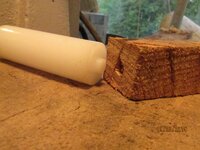TurtleTom
Member
I had all that HDPE left over from making mandrel cones so I decided to solve a problem I was having with glue ups. When I put the CA on the tube resting on my insertion tool and put it in the blank, wherever the tube stopped was where it stayed. I made a few short pens and gave them away.
So I put a 7mm short stub on a piece of HDPE which inserts in the back of the blank and prevents the tube from going out the other side or even up against the far side of the blank. You can see in the photo about how big it is. I put them together and hold it up against the lathe when I push the tube in.
It works really well. I made a slimline using the backstop and I had my first perfect glue up, even 2 of them.
I hope this helps someone else.
So I put a 7mm short stub on a piece of HDPE which inserts in the back of the blank and prevents the tube from going out the other side or even up against the far side of the blank. You can see in the photo about how big it is. I put them together and hold it up against the lathe when I push the tube in.
It works really well. I made a slimline using the backstop and I had my first perfect glue up, even 2 of them.
I hope this helps someone else.
Attachments
Last edited:

